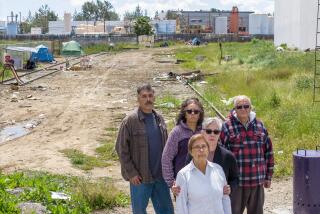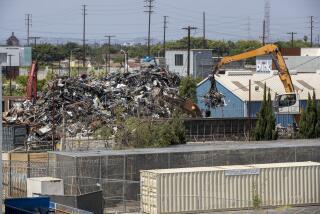California expands lead soil testing area near Exide plant in Vernon
State regulators have greatly expanded the area of homes, schools and parks that will be tested for lead-tainted soil near a troubled battery recycling plant in Vernon.
California toxic waste regulators blame air pollution from the Exide Technologies plant for the elevated levels of lead detected last fall at 39 homes and a preschool in Maywood and Boyle Heights, prompting officials to issue health warnings for pregnant women and children, and require additional testing. Workers began removing contaminated soil from two homes in Boyle Heights near the facility Monday.
------------
FOR THE RECORD:
Exide plant: In a graphic with an article in the Aug. 12 LATExtra section about lead testing near a battery recycling plant in Vernon, Rowan Avenue Elementary school was misidentified as Rowena Avenue Elementary School.
------------
The expanded test area will include at least 144 homes in a two-square mile area of southeast Los Angeles County.
The new tests ordered by the state Department of Toxic Substances Control will be conducted over the next two months in neighborhoods north and south of the Exide plant, one of only two lead acid battery smelters west of the Rocky Mountains.
State officials suspect the lead found at nearby homes was carried airborne and deposited over many years.
The facility, about five miles southeast of downtown Los Angeles, opened in 1922 and was taken over by Exide in 2000. The plant is shut temporarily under an agreement with air quality regulators. It has been a source of community outrage since a health study last year found its arsenic emissions posed an elevated cancer risk to the surrounding neighborhoods.
Exide has been cited repeatedly by air quality officials in recent years, mostly for emitting too much lead.
The neighborhoods being tested extend from Maywood and Boyle Heights into Huntington Park and unincorporated parts of East Los Angeles. Schools and play areas at public parks will also be sampled.
More than 60,000 people live in the area and about 98% of them are Hispanic, according to a Times analysis of 2010 Census data. About 8,000 children age 6 and younger live in the those areas, The Times analysis found.
Lead poses a health risk to young children because they can play in the dirt, and ingest tainted dust that can lead to learning disabilities.
Officials have stressed the levels found in the soil do not pose an acute risk. Since the contamination was discovered last fall, however, health officials have instructed residents to keep away from soil, wash their hands after touching it and grow vegetables only in raised beds.
But community activists and environmental groups say the extent of the soil contamination remains unknown because not enough homes have been tested.
At a news conference Monday in Boyle Heights, they accused Exide and the toxics department of being slow to act. They demanded swift replacement of soil at all properties where lead exceeds 80 parts per million, the level at which California recommends further health screenings.
“We need full cleanup to make sure that people feel safe in their homes, in their schools and in their communities,” said Ramya Sivasubramanian, an attorney with the Natural Resources Defense Council.
Rizgar Ghazi, chief of permitting for the state agency, said an order issued last year requires Exide to test the soil of selected homes at increasing distances from its plant until lead concentrations fall below 80 parts per million. The company will then have to clean up any home that exceeds 400 parts per million, he said, as well as any home above 80 parts per million if it has bare soil.
Exide has disputed the state’s requirements and is arguing it should be responsible only for soil above 400 parts per million, the threshold used by the U.S. Environmental Protection Agency.
“We’re trying to do the right thing,” said Thomas Strang, Exide’s vice president for environmental health and safety. He blamed much of the contamination on other sources, including lead-based paint used in older homes, leaded gasoline that was phased out decades ago and other smelters and steel mills that have operated in the heavily industrial city of Vernon.
“We are not claiming responsibility for all the lead in L.A.,” he said. “There’s too many other contributing factors.”
Under orders from state regulators, contractors hired by Exide on Monday began a weeklong project to excavate, haul away and replace up to 18 inches of soil from the front and back yards of two Boyle Heights homes where the highest concentrations were found. One home had samples more than 580 parts per million, while the other was more than 450 parts per million.
Salvador Chavez, 84, who lives in one of the two houses with his daughter and her adult children, watched Monday as crews arrived to begin digging up his yard with small excavators, wheelbarrows and shovels.
“I hope this is just the beginning and that they continue cleaning up all the contamination, wherever they find it,” the retired steel construction worker said in Spanish.
The Vernon plant, which can process about 25,000 automotive batteries a day, suspended operations in March because it could not meet tough new rules adopted by the South Coast Air Quality Management District. Under a deal reached last month with the air district, the company agreed to keep the facility closed until it installs new pollution controls.
The state toxics department denied a public records request from The Times to pinpoint sampling locations of the 39 homes originally tested, saying a release would violate the privacy of homeowners.
Twitter: @tonybarboza
Times staff writer Jon Schleuss and Times Data Analyst Sandra Poindexter contributed to this report.







